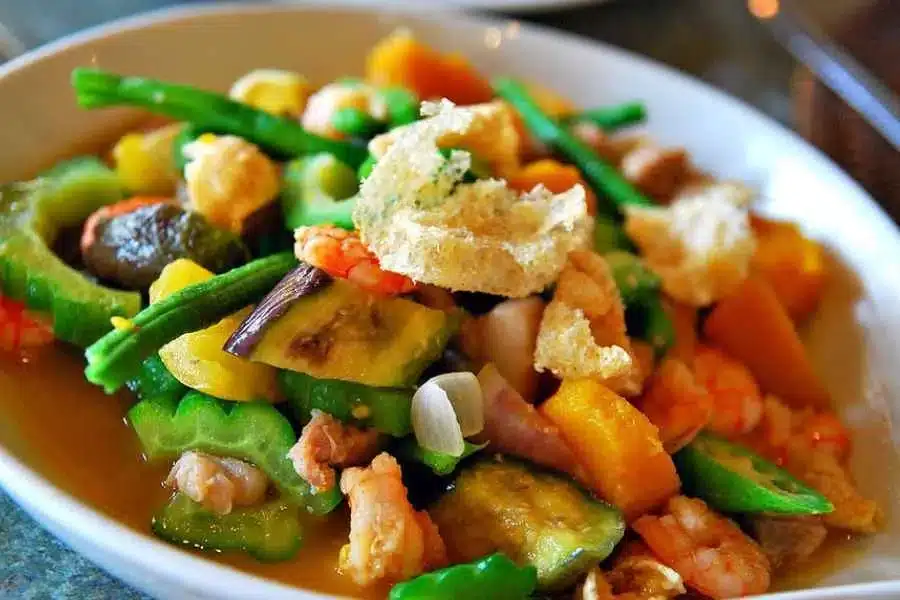Pinakbet is a common dish in Filipino homes, and every family has their own version. It’s a tasty stew filled with veggies and often seasoned with fermented fish paste or shrimp paste. Pakbet or Pinakbet is an easy-to-cook dish packed with vitamins and minerals.
Luckily, at our farmers’ markets, Filipino vendors often have bags of pre-cut mixed vegetables ready for making stew. Pinakbet Tagalog is not only delicious but also nutritious. It is a classic Filipino stew that works well as a main dish or a side with fried fish or grilled meat. It is often cooked in a clay pot called “Palayok” with anchovy sauce (bagoong isda) for flavor.
The name Pinakbet comes from the word “pinakbet,” meaning “shriveled” or “shrunk.” Ingredients are neatly arranged in a pot, cooked on high heat until boiling, and tossed by shaking the pot for even cooking. Not to be confused with the Tagalog version, which uses shrimp paste and sweet potato instead of squash. For an indulgent twist, top it with slices of Crunchy Puffed Skin Lechon Kawali or the famous Ilocos Bagnet.
The Story Behind Recipe
The Pinakbet recipe has its roots in the history of migration and cultural exchange between the Philippines and Hawaii.
In the early 20th century, many Filipino workers moved to Hawaii for jobs in sugarcane and pineapple plantations, and they brought their favorite dish, Pinakbet, with them.
As the Filipino community settled in Hawaii, they adjusted their traditional recipes by using local ingredients found on the islands. Hawaii’s diverse agriculture offered veggies like bitter melon, eggplant, squash, beans, and okra—similar to those used in Pinakbet.
Coconut milk was abundant in Hawaiian cuisine, so it naturally became part of Filipino dishes. This mix of Filipino and Hawaiian ingredients and cooking styles gave birth to the Pinakbet Hawaii-style recipe. While keeping its veggie essence, the dish got a unique Hawaiian touch with coconut milk and local seafood like shrimp, abundant in Hawaii.
Today, Pinakbet Hawaii-style is loved by both the Filipino and Hawaiian communities. It shows how food can bring different cultures together, creating something new and delicious.
The blend of Filipino and Hawaiian influences has created a tasty dish that honors Filipino heritage while celebrating the richness of Hawaii’s culinary traditions.
How To Cool Pinakbet

Ingredients
- 1 pound shrimp, peeled and deveined
- 1 small bitter melon (ampalaya), sliced and deseeded
- 1 cup okra, trimmed
- 1 medium-sized eggplant, sliced
- 1 cup long beans or green beans, cut into 2-inch pieces
- 1 cup kabocha squash or calabaza, cubed
- 1 cup cherry tomatoes
- 4 cloves garlic, minced
- 1 thumb-sized piece of ginger, julienned
- 1 medium onion, sliced
- 2 cups fresh spinach or kangkong leaves
- 2 tablespoons cooking oil
- 1 tablespoon soy sauce
- 1 tablespoon oyster sauce
- 1 tablespoon fish sauce (patis)
- 1 tablespoon brown sugar
- 1 cup coconut milk
- Salt and pepper (according to taste)
Step-by-step instructions for making Pinakbet
- Get your veggies ready by washing and cutting them as told.
- In a big wok or pan, heat up cooking oil on medium. Put in minced garlic and cook until it smells good.
- Toss in sliced onion and julienned ginger. Keep cooking until the onion gets see-through.
- Now, add shrimp to the wok and cook until they turn pink. Take them out and set them aside.
- In the same wok, throw in cubed kabocha squash and bitter melon slices. Cook until they start to get soft.
- Add long beans and okra. Stir and cook for a couple more minutes.
- Pour in fish sauce, soy sauce, and oyster sauce over the veggies. Mix well so the flavors spread.
- Toss in cherry tomatoes and gently stir.
- Pour in coconut milk and let everything simmer for a bit until the veggies are cooked but still a bit crisp.
- Bring back the cooked shrimp and mix them with the veggies.
- Season with brown sugar, salt, and pepper as you like. Adjust the seasoning however you want.
- Put fresh spinach or kangkong leaves in the pan and cook until they wilt.
- Once everything is cooked and mixed, take the wok off the heat.
- Serve the Pinakbet Hawaii-style hot with steamed rice.
Tips for making Pinakbet
- Make sure everything cooks evenly by cutting ingredients to the same sizes, like keeping long beans the same length.
- To keep veggies vibrant and a bit crunchy, don’t cook them too long. They should be tender but still have a slight crispness.
- For a lighter version, use less coconut milk or go for the light kind. If you’re all about creaminess, add more coconut milk.
- If bitter melon is too bitter for you, blanch it in boiling water for a few minutes before adding it to the dish. This can help tone down its bitterness.
Flavourful substitute
- Shrimp: If you don’t like seafood, you can leave out the shrimp or replace it with cubed tofu or tempeh for a vegetarian choice.
- Kabocha Squash or Calabaza: You can use Butternut squash or acorn squash instead of Kabocha Squash or Calabaza.
- Fresh Spinach or Kangkong Leaves: Baby spinach or Swiss chard can be used instead of Fresh Spinach or Kangkong Leaves.
- Bitter Melon (Ampalaya): If you don’t have bitter melon, you can use zucchini instead of bitter melon.
- Okra: instead of okra you can use sliced bell peppers.
Serving suggestions
- Rice: Pinakbet pairs perfectly with steamed white or brown rice. The flavorful sauce from the dish complements the rice, creating a satisfying combination.
- Grilled Meat: Serve Pinakbet as a side dish alongside grilled chicken, pork, or beef. The savory and slightly sweet flavors of the grilled meat complement the vegetable stew.
- Fried Fish: The rich and robust flavors of Pinakbet contrast well with the simplicity of fried fish. The crispy texture of the fish adds a delightful element to the meal.
- Bagoong (Shrimp Paste): Some enjoy Pinakbet with a side of bagoong, a fermented shrimp paste. It adds an extra layer of savory and umami flavor to the dish.
- Fresh Herbs: Garnish with fresh herbs like chopped cilantro or parsley just before serving. The herbs add a burst of freshness and color to the dish.








